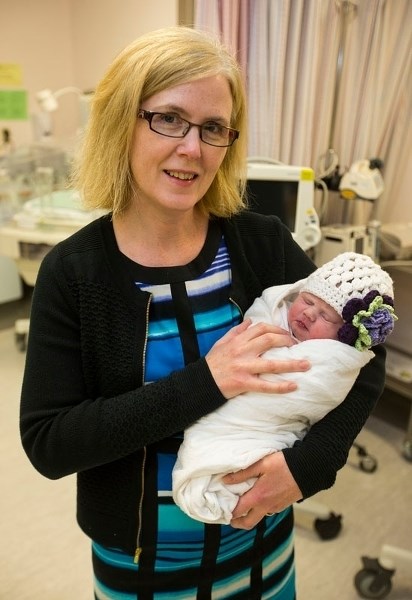After 15 years of delivering babies at the Sturgeon Community Hospital, Dr. Eva DeDoming has watched the community grow – and the number of births along with it.
Now the obstetrics site chief at the St. Albert hospital, she recalls things have become much busier in the obstetrics ward over the years.
“The year I started here, there were 1,417 deliveries. There were, last year, 2,871,” she said. “That’s massive. It’s doubled since 2000.”
At that time there were five obstetricians in the rotation, a number that has actually dropped in recent years. A new hire this year brings the total back up to five, something DeDoming said would probably mean a further increase in birth rates at the hospital.
“I would strongly suggest it’s destined to increase again, because we now have an additional obstetrician doing deliveries over what we’ve had in quite some time,” she said.
She added she hopes to soon see a sixth obstetrician brought on to help manage the growing number of deliveries.
While the increase in births at the Sturgeon between 2000 and 2010 was significant, the rate of increase has slowed significantly since then, although it’s still growing.
Figures provided by Alberta Health Services show there were 2,843 births at the hospital in 2014, up eight per cent from the 2,612 births in 2010. That five-year rate of growth is slower than the 12 per cent seen across the Edmonton zone over five years and the approximately 10 per cent seen across the province over the four years between 2010 and 2013 – 2014 figures were not available.
DeDoming said even though the rate of increase has slowed, the increasing number of births presents a challenge to the health professionals at the hospital since the 17-unit obstetrics ward was built to accommodate 1,700 births per year. Although six additional rooms have been provided for the obstetrics program in a shared unit, there is still a need for more space, including a dedicated operating theatre for caesarean-section births.
She said obstetric surgery is currently done in the same operating room as gynecological surgery, meaning those surgeries are sometimes delayed when the obstetricians need the space.
C-section births represent about one fifth of the births at the Sturgeon, according to hospital manager Wendy Tanaka Collins, and although that percentage is lower than what is seen in other Edmonton-zone hospitals, the need for dedicated space is apparent.
“We’re getting pretty close to 3,000 deliveries a year; we do need to have a dedicated c-section room so we’re working on trying to build that capacity,” she said.
Tanaka Collins said the hospital is also looking at establishing a six-unit neonatal care ward to offer a higher level of care to newborn babies who need it.
DeDoming said she sees neonatal care as a high priority since right now they can resuscitate and stabilize but babies who need a high level of ongoing care must go to other hospitals in the region.
“Even though most of our deliveries are lower risk, we have babies who get into trouble and need more intensive care,” she said. “We don’t have anywhere for that to happen on site.”
While much of the growth could be attributed to population growth in the St. Albert area, DeDoming said there are many reasons why women from Edmonton and around northern Alberta might choose to deliver at the Sturgeon.
Most significant, she suggested, is the fact labour, delivery, post-partum and recovery care are all provided in the same room, meaning mother and baby don’t need to move around at all during the process. Other hospitals in the region have separate spaces for different parts of the birth process.
“It’s beneficial because there’s less potential for infection risk and those kinds of things, and there’s just less moving patients around which is very, very nice for the patients,” she said. “Patients certainly like it and come back here because of that.”



